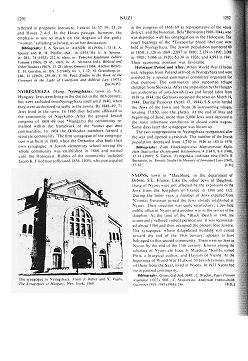[18th century - synagogues in the 1880s - Jewish
elementary school - rabbis - Tiszaeszlar blood libel case]
<Nyiregyhaza,
(Hung. Nyiregyháza), town in N.E. Hungary.
Jews were living in the district in the 18th century, but
were excluded from Nyiregyhaza itself until 140, when they
were authorized to settle in the towns.
By 1848-49, 71 Jews lived in the town. In 1865 they became
affiliated to the community of Nagykallo. After the general
Jewish congress of 1868-69 (see *Hungary) the community
remained within the framework of the *status quo ante
communities. In 1904 the Orthodox members formed a separate
community. The first synagogue of the congregation was built
in 1880, when the Orthodox also built their own synagogue. A
Jewish elementary school serving the whole community was
established in 1868 and existed until the Holocaust. Rabbis
of the community included Jacob K. Friedman (officiated
1856-1905), who participated [col. 1291]
in the congress of 1868-69 as representative of the whole
district; and the historian, Bela *Bernstein (1900-1944),
who was deported with his congregation in the Holocaust. The
court hearings of the *Tiszaeszlar blood libel case were
held in Nyiregyhaza.
[Numbers]
The Jewish population numbered
60 in 1850;
1,128 in 1869;
2,097 in 1880;
2,159 in 1890;
3,008 in 1900;
5,066 in 1920;
5,134 in 1936;
and 4,993 in 1941.
Their economic position was favorable.
Holocaust Period and After.
[Jewish refugees from
Poland since Sep. 1939]
When World War II broke out, refugees from Poland arrived in
Nyiregyhaza and were assisted by a special communal
committee organized for that purpose. The community also
supported refugee children from Slovakia.
[[Hungary was probably becoming a hot spot for Jewish
refugees from Austria, CSSR, Poland, and after 1941 also
from Yugoslavia. This should be investigated!]].
[NS occupation and
deportation]
After the imposition by the Hungarian authorities of
anti-Jewish laws and forced labor from 1938 to 1944, the
Germans occupied the town on March 19, 1944 [[with willing
Hungarian collaborators]]. During Passover (April 17, 1944)
S.S. units herded the Jews of the town and from 36
surrounding villages, totaling 17,850, into the ghetto. At
the end of May and beginning of June, more than 5,000 Jews
were deported in the most inhumane conditions in closed
cattle wagons. Some days later the synagogue was blown up.
The two congregations in Nyiregyhaza reorganized after the
war and opened a yeshivah. the number of the Jewish
population decreased from 1,210 in 1946 to 180 in 1970
[[because of emigration and integration]].
Bibliography
-- Zsidó Világkongresszus Magyarországi Képviselete
Statisztikai Osztátyanak Közleményei, 4 (1947), 8-9 (1948),
13-14 (1949)
-- S. Gervai: Nyiregháza zsidósága élete (1963)
-- B. Bernstein, in: Semitic Studies in Memory of Immanuel
Loew (1947), 57-62
[L.H.]>



